heater JEEP COMPASS 2013 1.G User Guide
[x] Cancel search | Manufacturer: JEEP, Model Year: 2013, Model line: COMPASS, Model: JEEP COMPASS 2013 1.GPages: 116, PDF Size: 2.71 MB
Page 21 of 116
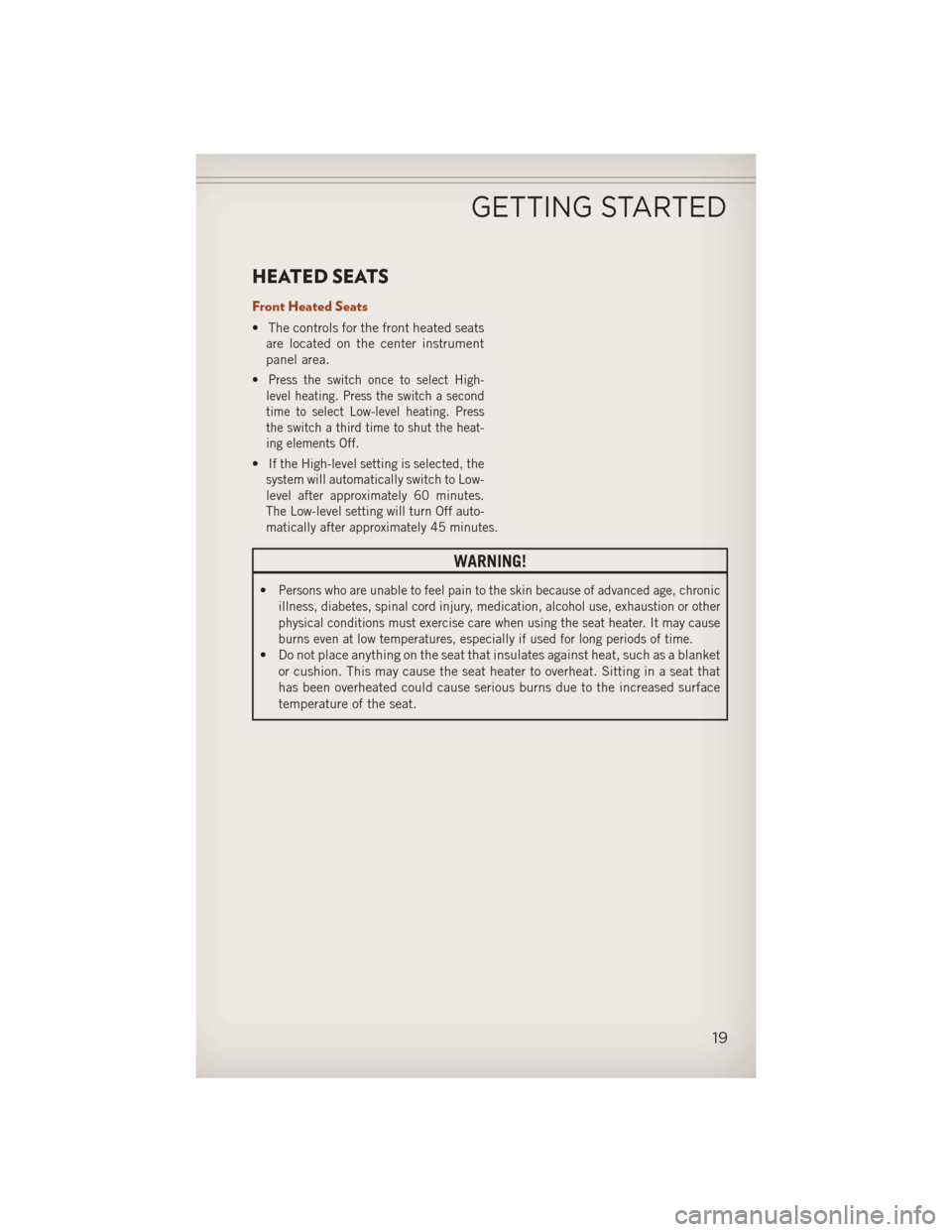
HEATED SEATS
Front Heated Seats
• The controls for the front heated seatsare located on the center instrument
panel area.
•
Press the switch once to select High-
level heating. Press the switch a second
time to select Low-level heating. Press
the switch a third time to shut the heat-
ing elements Off.
•If the High-level setting is selected, the
system will automatically switch to Low-
level after approximately 60 minutes.
The Low-level setting will turn Off auto-
matically after approximately 45 minutes.
WARNING!
•Persons who are unable to feel pain to the skin because of advanced age, chronic
illness, diabetes, spinal cord injury, medication, alcohol use, exhaustion or other
physical conditions must exercise care when using the seat heater. It may cause
burns even at low temperatures, especially if used for long periods of time.
• Do not place anything on the seat that insulates against heat, such as a blanket
or cushion. This may cause the seat heater to overheat. Sitting in a seat that
has been overheated could cause serious burns due to the increased surface
temperature of the seat.
GETTING STARTED
19
Page 53 of 116
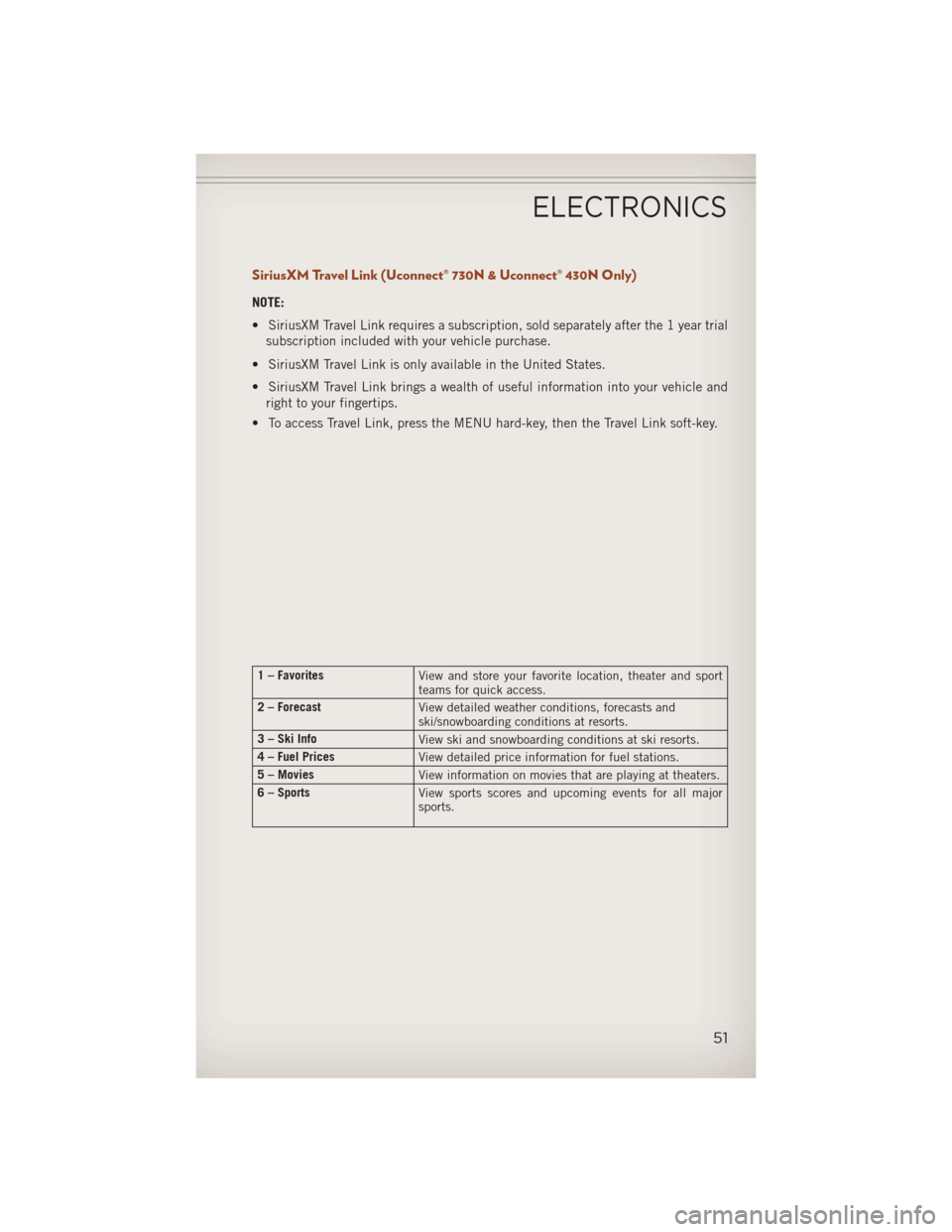
SiriusXM Travel Link (Uconnect® 730N & Uconnect® 430N Only)
NOTE:
• SiriusXM Travel Link requires a subscription, sold separately after the 1 year trialsubscription included with your vehicle purchase.
• SiriusXM Travel Link is only available in the United States.
• SiriusXM Travel Link brings a wealth of useful information into your vehicle and right to your fingertips.
• To access Travel Link, press the MENU hard-key, then the Travel Link soft-key.
1 – Favorites View and store your favorite location, theater and sport
teams for quick access.
2 – Forecast View detailed weather conditions, forecasts and
ski/snowboarding conditions at resorts.
3 – Ski Info View ski and snowboarding conditions at ski resorts.
4 – Fuel Prices View detailed price information for fuel stations.
5 – Movies View information on movies that are playing at theaters.
6 – Sports View sports scores and upcoming events for all major
sports.
ELECTRONICS
51
Page 76 of 116
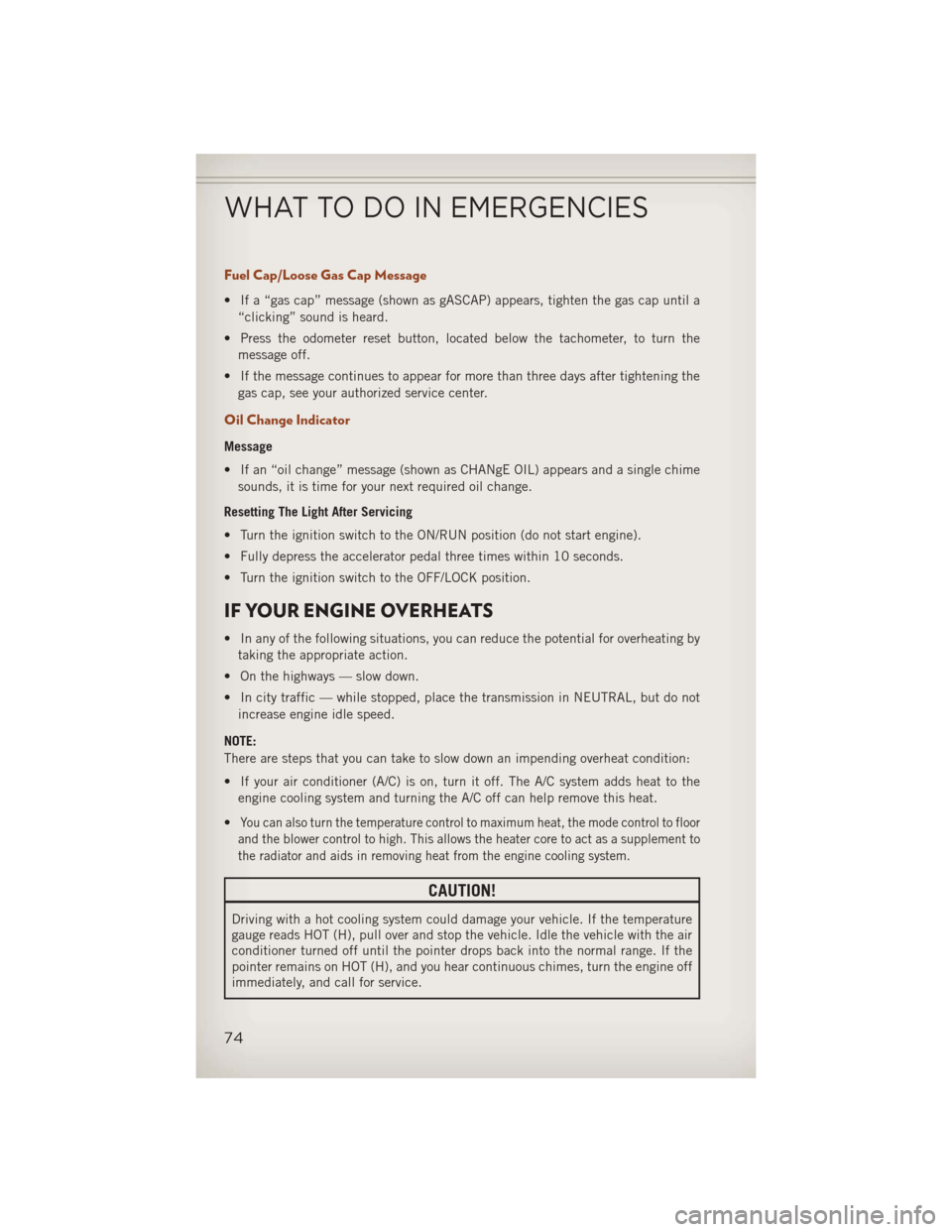
Fuel Cap/Loose Gas Cap Message
• If a “gas cap” message (shown as gASCAP) appears, tighten the gas cap until a“clicking” sound is heard.
• Press the odometer reset button, located below the tachometer, to turn the message off.
• If the message continues to appear for more than three days after tightening the gas cap, see your authorized service center.
Oil Change Indicator
Message
• If an “oil change” message (shown as CHANgE OIL) appears and a single chimesounds, it is time for your next required oil change.
Resetting The Light After Servicing
• Turn the ignition switch to the ON/RUN position (do not start engine).
• Fully depress the accelerator pedal three times within 10 seconds.
• Turn the ignition switch to the OFF/LOCK position.
IF YOUR ENGINE OVERHEATS
• In any of the following situations, you can reduce the potential for overheating by taking the appropriate action.
• On the highways — slow down.
• In city traffic — while stopped, place the transmission in NEUTRAL, but do not increase engine idle speed.
NOTE:
There are steps that you can take to slow down an impending overheat condition:
• If your air conditioner (A/C) is on, turn it off. The A/C system adds heat to the engine cooling system and turning the A/C off can help remove this heat.
•
You can also turn the temperature control to maximum heat, the mode control to floor
and the blower control to high. This allows the heater core to act as a supplement to
the radiator and aids in removing heat from the engine cooling system.
CAUTION!
Driving with a hot cooling system could damage your vehicle. If the temperature
gauge reads HOT (H), pull over and stop the vehicle. Idle the vehicle with the air
conditioner turned off until the pointer drops back into the normal range. If the
pointer remains on HOT (H), and you hear continuous chimes, turn the engine off
immediately, and call for service.
WHAT TO DO IN EMERGENCIES
74
Page 83 of 116
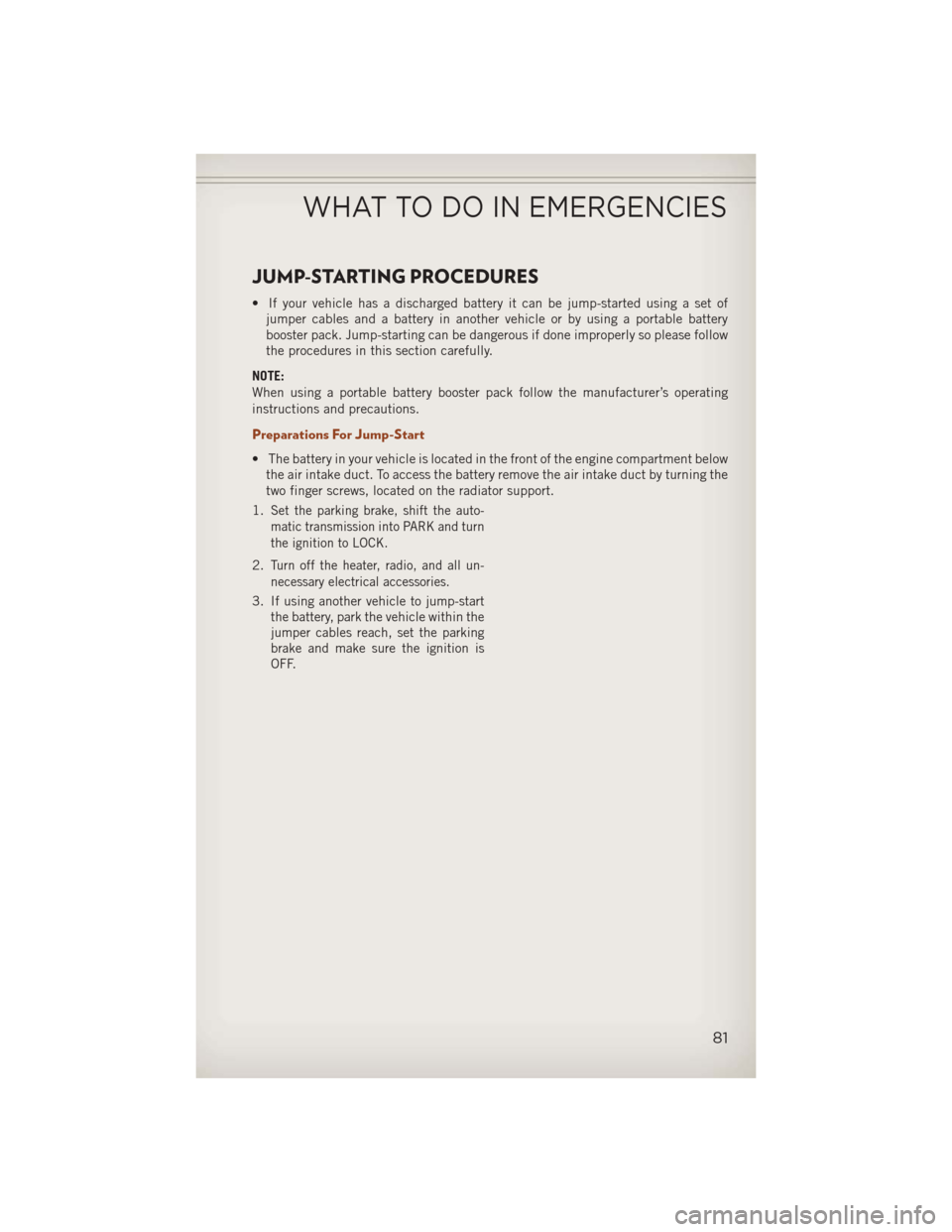
JUMP-STARTING PROCEDURES
• If your vehicle has a discharged battery it can be jump-started using a set ofjumper cables and a battery in another vehicle or by using a portable battery
booster pack. Jump-starting can be dangerous if done improperly so please follow
the procedures in this section carefully.
NOTE:
When using a portable battery booster pack follow the manufacturer’s operating
instructions and precautions.
Preparations For Jump-Start
• The battery in your vehicle is located in the front of the engine compartment below the air intake duct. To access the battery remove the air intake duct by turning the
two finger screws, located on the radiator support.
1.
Set the parking brake, shift the auto-
matic transmission into PARK and turn
the ignition to LOCK.
2.Turn off the heater, radio, and all un-
necessary electrical accessories.
3.If using another vehicle to jump-start
the battery, park the vehicle within the
jumper cables reach, set the parking
brake and make sure the ignition is
OFF.
WHAT TO DO IN EMERGENCIES
81
Page 92 of 116
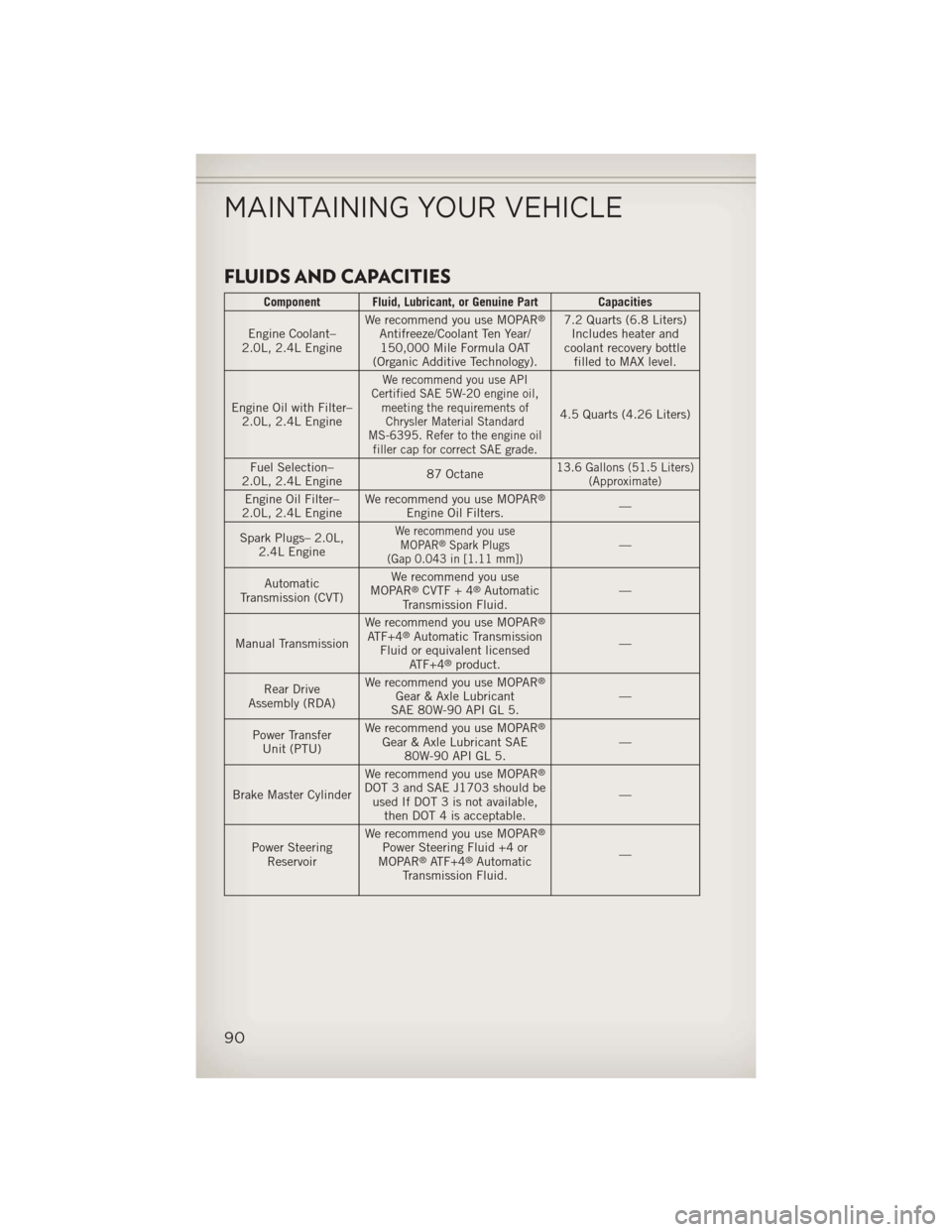
FLUIDS AND CAPACITIES
Component Fluid, Lubricant, or Genuine Part Capacities
Engine Coolant–
2.0L, 2.4L Engine We recommend you use MOPAR®
Antifreeze/Coolant Ten Year/
150,000 Mile Formula OAT
(Organic Additive Technology). 7.2 Quarts (6.8 Liters)
Includes heater and
coolant recovery bottle filled to MAX level.
Engine Oil with Filter– 2.0L, 2.4L Engine
We recommend you use API
Certified SAE 5W-20 engine oil, meeting the requirements ofChrysler Material Standard
MS-6395. Refer to the engine oil filler cap for correct SAE grade.
4.5 Quarts (4.26 Liters)
Fuel Selection–
2.0L, 2.4L Engine 87 Octane
13.6 Gallons (51.5 Liters)
(Approximate)
Engine Oil Filter–
2.0L, 2.4L Engine We recommend you use MOPAR®
Engine Oil Filters.
—
Spark Plugs– 2.0L, 2.4L Engine
We recommend you useMOPAR®Spark Plugs
(Gap 0.043 in [1.11 mm])—
Automatic
Transmission (CVT) We recommend you use
MOPAR
®CVTF + 4®Automatic
Transmission Fluid. —
Manual Transmission We recommend you use MOPAR
®
ATF+4®Automatic Transmission
Fluid or equivalent licensed ATF+4
®product. —
Rear Drive
Assembly (RDA) We recommend you use MOPAR®
Gear & Axle Lubricant
SAE 80W-90 API GL 5. —
Power Transfer Unit (PTU) We recommend you use MOPAR
®
Gear & Axle Lubricant SAE
80W-90 API GL 5. —
Brake Master Cylinder We recommend you use MOPAR
®
DOT 3 and SAE J1703 should be
used If DOT 3 is not available, then DOT 4 is acceptable. —
Power Steering Reservoir We recommend you use MOPAR
®
Power Steering Fluid +4 or
MOPAR®ATF+4®Automatic
Transmission Fluid. —
MAINTAINING YOUR VEHICLE
90
Page 99 of 116
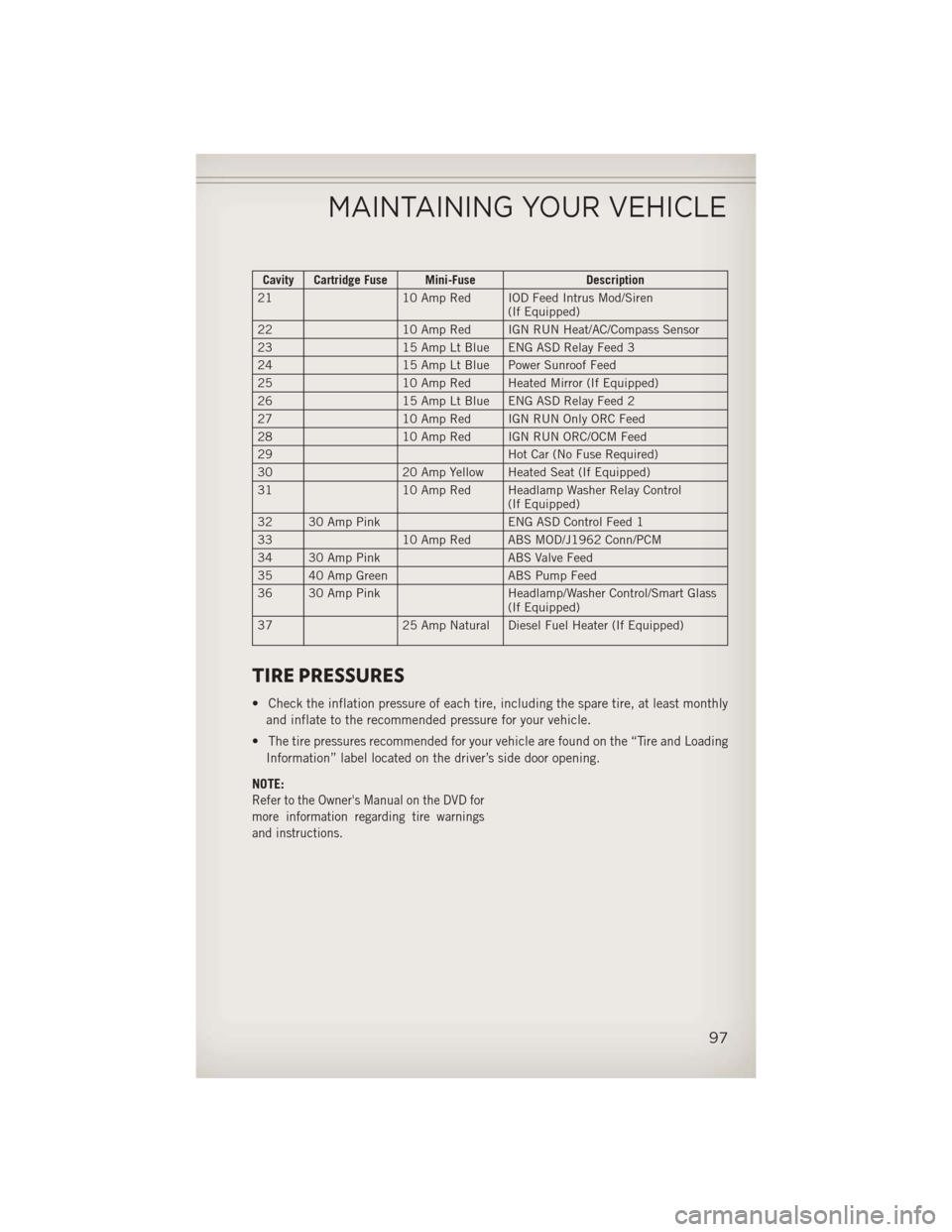
Cavity Cartridge Fuse Mini-FuseDescription
21 10 Amp Red IOD Feed Intrus Mod/Siren
(If Equipped)
22 10 Amp Red IGN RUN Heat/AC/Compass Sensor
23 15 Amp Lt Blue ENG ASD Relay Feed 3
24 15 Amp Lt Blue Power Sunroof Feed
25 10 Amp Red Heated Mirror (If Equipped)
26 15 Amp Lt Blue ENG ASD Relay Feed 2
27 10 Amp Red IGN RUN Only ORC Feed
28 10 Amp Red IGN RUN ORC/OCM Feed
29 Hot Car (No Fuse Required)
30 20 Amp Yellow Heated Seat (If Equipped)
31 10 Amp Red Headlamp Washer Relay Control
(If Equipped)
32 30 Amp Pink ENG ASD Control Feed 1
33 10 Amp Red ABS MOD/J1962 Conn/PCM
34 30 Amp Pink ABS Valve Feed
35 40 Amp Green ABS Pump Feed
36 30 Amp Pink Headlamp/Washer Control/Smart Glass
(If Equipped)
37 25 Amp Natural Diesel Fuel Heater (If Equipped)
TIRE PRESSURES
•Check the inflation pressure of each tire, including the spare tire, at least monthly
and inflate to the recommended pressure for your vehicle.
•The tire pressures recommended for your vehicle are found on the “Tire and Loading
Information” label located on the driver’s side door opening.
NOTE:
Refer to the Owner's Manual on the DVD for
more information regarding tire warnings
and instructions.
MAINTAINING YOUR VEHICLE
97